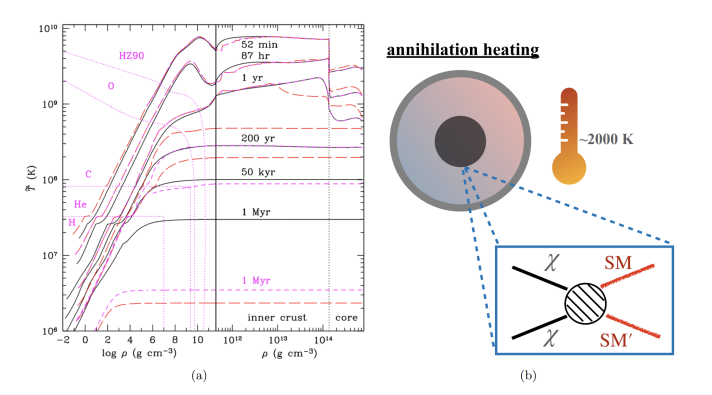| GO BACK (DESKTOP VIEW) | GO BACK (MOBILE VIEW) |
Thermal Evolution of Dark Matter-Admixed Neutron Stars
StudentMaya Ednie Principal Mentor:Peter Rau (email: prau@uw.edu) Co-Mentor:Mia Kumamoto (email: mialk@uw.edu) Prerequisites:Some programming experience (especially with Python) will be helpful but is not required. Access to a computer running macOS, Linux, or the Linux Subsystem for Windows is also required. What Students Will Do:Students will use the spectral method partial differential equation solver Dedalus (https://dedalus-project.readthedocs.io/en/latest/) to simulate the thermal evolution of neutron stars. They will be responsible for implementing the dark matter-induced heating terms, and running the code for different stellar models and microscopic parameters. Expected Project Length:6 - 12 months
|
Image Description and Captions: (a) Examples of neutron star cooling curves without internal heating [2], showing gravitationally red-shifted temperature T as a function of density ρ at various stellar ages. (b) Annihilation of dark matter χ into baryonic matter SM, an example of a dark matter heating process [1]. |
Project Description:
Only about one-sixth of the matter in the universe is the baryonic matter that we are familiar with. The remainder is dark matter, so-called because it does not interact with light and whose existence is only observed indirectly through its gravitational interaction, which is responsible for weak gravitational lensing and the observed galactic rotation curves. Many terrestrial experiments have attempted to detect the dark matter which should be passing through the Earth as it moves within the galaxy. So far, these have only been able to place constraints on the properties of dark matter but have not detected it. This has prompted physicists to consider new astronomical avenues for understanding dark matter.
Because of their high densities and low temperatures, neutron stars are a prime candidate for new astrophysical searches for dark matter [1]. Small amounts of dark matter can be captured by their strong gravitational field, and new physics beyond the Standard Model could generate dark matter within neutron star cores from decays of baryonic matter. A possible signature of such a mechanism would be if it modifies the observed cooling of neutron stars, the temperatures of which can be inferred based on observation by X-ray telescopes. The timing and size of this effect could be used to constraint the mass of dark matter and the strength and form of its interaction with baryonic matter.
The goal of this project is to run computer simulations of the temperature evolution of neutron stars containing dark matter. Specifically, the dark matter may introduce novel heating mechanisms which could change the standard neutron star cooling based on neutrino and photon emission. Determining how the cooling curve is changed based on the amount and distribution of dark matter within the star and the properties of the dark matter particles will allow us to judge whether observing these effects is realistic and how much we can distinguish between different dark matter models using them.
References:
[1] J. Bramanate and N. Raj, “Dark matter in compact stars”, arXiv:2307.14435 (2023).
[2] A. Y. Potekhin and G. Chabrier, “Magnetic neutron star cooling and microphysics”, Astron. Astrophys. 609, A74 (2018).

